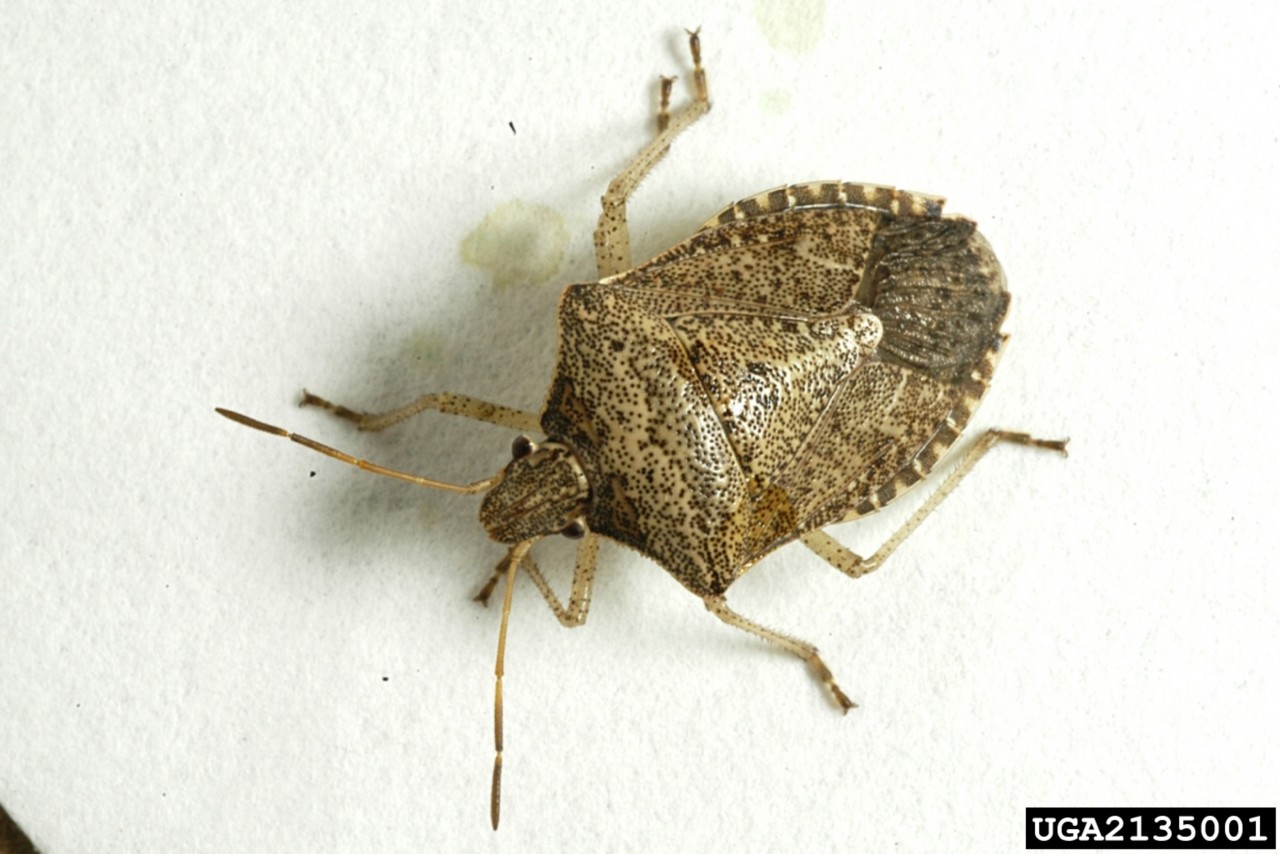Reports of stink bug injury in soybean have increased over the past several years in the Midwest. While usually only a small number of fields exhibit economic injury, the injury is widespread and can be devasting in areas within infested fields. Stink bugs or shield bugs have piercing-sucking mouthparts. Upon piercing the plant tissue, saliva is pumped into the plant to begin the digestive process. While the stylet itself can cause mechanical injury, the material pumped into the plant in combination with the mechanical injury is thought to result in the damage symptoms observed in the field.
Species and Biology1
There are several species of stink bugs that can injure soybean; however, the brown stink bug (Figure 1), southern green stink bug, and one-spotted stink bug are the most common in the southeastern United States, while in the Central Plains, in addition to the previously mentioned species, the green stink bug (Figure 2) and red shouldered stink bug (Figure 3) have also been reported to damage soybean and corn. For more information about stinkbugs in corn, please read Common Stink Bugs in Corn. Recently, a new invasive species, the brown marmorated stink bug (Figure 4), is also becoming a concern in the eastern U.S. and the Midwest.




While there are several species, the biology and injury they cause is similar. Adults overwinter in protected locations; in the case of the brown marmorated stink bug, it is usually a home. Females deposit barrel-shaped eggs in a mass of 15 to 20 on host plant leaves (Figure 5). The eggs hatch in mass and in some cases, the female guards both the egg mass and developing nymphs. In some cases, the nymphs look nothing like the adult in coloration (Figure 6). Feeding by both the adults and nymphs can result in injury.


Stink Bug Injury and Plant Damage1
Stink bugs can feed on all above-ground parts of soybean but prefer pods and developing seeds. The final nymphal stage and adults cause the most severe injury. In the Midwest, stink bugs usually begin colonizing soybean during the reproductive stages. Populations increase and peak during pod and seed development. Abundance can be influenced by planting date and relative maturity of the variety. The severity of the damage is mainly dependent on soybean developmental stage at the time of feeding. Feeding at early pod and seed set can result in pod loss and seed abortion. If feeding occurs when seeds are developing it can result in deformed seeds. Stink bug feeding can also impact maturation of the plant when feeding occurs during pod fill, as it results in “stay-green” syndrome.
Scouting Strategies and Treatment Guidelines1
Scouting should begin as pods begin to develop and continue through seed development, approximately the R6 stage. Sampling can be done with a sweep net or drop cloth; a sweep net is usually preferred as it is easier to use and takes less time. As with corn, focus on field margins and if stink bugs are found on the margins, sample portions of the interior of the field as well.
Treatment Guidelines2,4
For the Midwest, combine both the adults and nymphs of all stink bugs into a single count. If the field is to be used for seed production, a threshold of 5 stink bugs per 25 sweeps should be considered, and if the crop is to be used for grain, use a threshold of 10 stink bugs per 25 sweeps.1 In the southeastern United States, the treatment threshold is slightly less, with 2.5 stink bugs per 15 sweeps if the crop is to be used for seed or edible market and 5 stink bugs per 15 sweeps if the crop is to be used for grain.5
Sources:
1Koch, R., Pezzini, D., Michel, A., and Hunt, T. 2017. Identification, biology, impacts, and management of stink bugs (Hemiptera: Heteroptera: Pentatomidae) of soybean and corn in the Midwestern United States. Journal of Integrated Pest Management Volume 8:1–14. https://academic.oup.com/jipm/article/8/1/11/3745633
2Townsend, L. and Bessin, R. Stink bug damage to corn. University of Kentucky Extension. https://entomology.ca.uky.edu/ef305
3Hunt, T., Wright, B., and Jarvi, K. Stink bugs reported in corn and soybean. University of Nebraska, Institute of Agriculture and Natural Resources. https://cropwatch.unl.edu/stink-bugs-reported-corn-and-soybeans
4Reisig, D. 2019. Scout before spraying stink bugs in corn. North Carolina State University Extension. https://corn.ces.ncsu.edu/2019/06/scout-before-spraying-stink-bugs-in-corn/
5Reisig, D. 2017. Stink bug economic threshold calculator. North Carolina State University Extension. https://soybeans.ces.ncsu.edu/stink-bug-economic-threshold-calculator/
4017_S1
